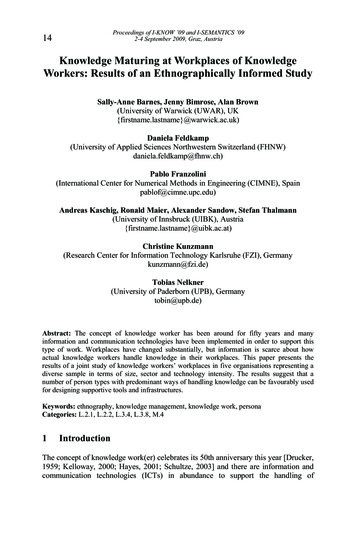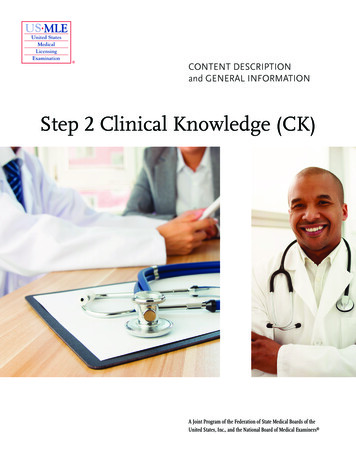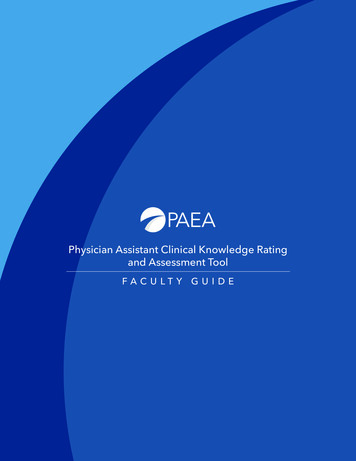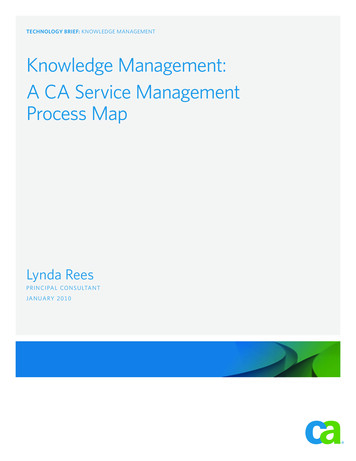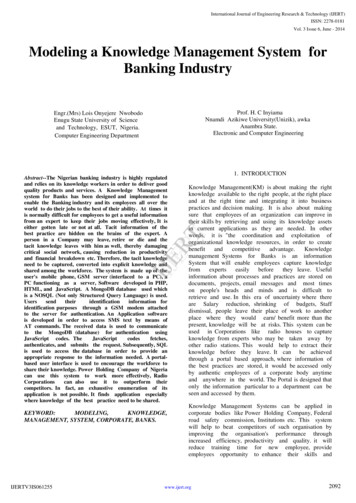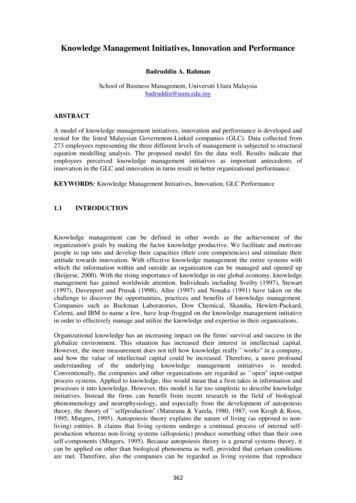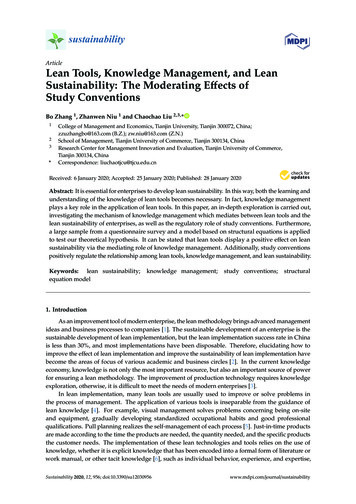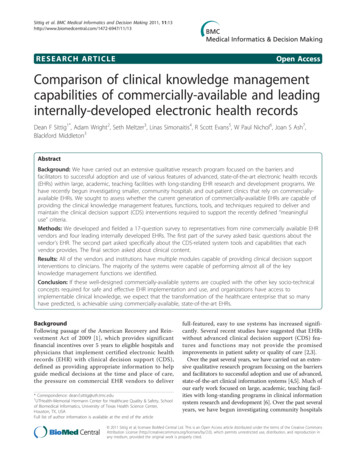
Transcription
Sittig et al. BMC Medical Informatics and Decision Making 2011, ESEARCH ARTICLEOpen AccessComparison of clinical knowledge managementcapabilities of commercially-available and leadinginternally-developed electronic health recordsDean F Sittig1*, Adam Wright2, Seth Meltzer3, Linas Simonaitis4, R Scott Evans5, W Paul Nichol6, Joan S Ash7,Blackford Middleton3AbstractBackground: We have carried out an extensive qualitative research program focused on the barriers andfacilitators to successful adoption and use of various features of advanced, state-of-the-art electronic health records(EHRs) within large, academic, teaching facilities with long-standing EHR research and development programs. Wehave recently begun investigating smaller, community hospitals and out-patient clinics that rely on commerciallyavailable EHRs. We sought to assess whether the current generation of commercially-available EHRs are capable ofproviding the clinical knowledge management features, functions, tools, and techniques required to deliver andmaintain the clinical decision support (CDS) interventions required to support the recently defined “meaningfuluse” criteria.Methods: We developed and fielded a 17-question survey to representatives from nine commercially available EHRvendors and four leading internally developed EHRs. The first part of the survey asked basic questions about thevendor’s EHR. The second part asked specifically about the CDS-related system tools and capabilities that eachvendor provides. The final section asked about clinical content.Results: All of the vendors and institutions have multiple modules capable of providing clinical decision supportinterventions to clinicians. The majority of the systems were capable of performing almost all of the keyknowledge management functions we identified.Conclusion: If these well-designed commercially-available systems are coupled with the other key socio-technicalconcepts required for safe and effective EHR implementation and use, and organizations have access toimplementable clinical knowledge, we expect that the transformation of the healthcare enterprise that so manyhave predicted, is achievable using commercially-available, state-of-the-art EHRs.BackgroundFollowing passage of the American Recovery and Reinvestment Act of 2009 [1], which provides significantfinancial incentives over 5 years to eligible hospitals andphysicians that implement certified electronic healthrecords (EHR) with clinical decision support (CDS),defined as providing appropriate information to helpguide medical decisions at the time and place of care,the pressure on commercial EHR vendors to deliver* Correspondence: dean.f.sittig@uth.tmc.edu1UTHealth-Memorial Hermann Center for Healthcare Quality & Safety, Schoolof Biomedical Informatics, University of Texas Health Science Center,Houston, TX, USAFull list of author information is available at the end of the articlefull-featured, easy to use systems has increased significantly. Several recent studies have suggested that EHRswithout advanced clinical decision support (CDS) features and functions may not provide the promisedimprovements in patient safety or quality of care [2,3].Over the past several years, we have carried out an extensive qualitative research program focusing on the barriersand facilitators to successful adoption and use of advanced,state-of-the-art clinical information systems [4,5]. Much ofour early work focused on large, academic, teaching facilities with long-standing programs in clinical informationsystem research and development [6]. Over the past severalyears, we have begun investigating community hospitals 2011 Sittig et al; licensee BioMed Central Ltd. This is an Open Access article distributed under the terms of the Creative CommonsAttribution License (http://creativecommons.org/licenses/by/2.0), which permits unrestricted use, distribution, and reproduction inany medium, provided the original work is properly cited.
Sittig et al. BMC Medical Informatics and Decision Making 2011, nd clinics that rely on commercially-available EHR systems [7]. Over these many years, we have seen many different types of EHR systems implemented in many differentsetting using many different techniques. A result of thiswork has been development of a new 8-dimension, sociotechnical model that we believe helps explain why someimplementations go well and others poorly [8]. Clearly, thequality of the technology (i.e., the first dimension of themodel), as measured by the features and functions that areavailable to end-users, plays a major role in any successfulimplementation. In an attempt to better quantify our qualitative findings that almost all of the EHR systems that wehave investigated have nearly the same basic features andfunctions, as evidenced by the fact that all of them havebeen CCHIT-approved, we decided to survey a selectgroup of commercial EHR vendors regarding their clinicaldecision support and knowledge management capabilities.In order to provide a reference context for the currentextent of CDS capabilities, we compared the surveyresponses of nine commercial vendors with those of fourleading internally-developed non-commercial systems.Chaudhry et al. found that approximately 25% of all English-language, peer-reviewed studies that have been usedto demonstrate the increases in quality and safety ofpatient care originated from only four U.S.A healthcareinstitutions (Intermountain Health Care, Salt Lake City,UT; Veterans Health Administration, Washington, D.C.;Regenstrief Institute, Indianapolis, IN; Brigham &Women’s Hospital, Boston, MA). Furthermore, thesefour institutions provided the majority (54 of 76) of thehigh-quality literature Chaudhry identified in this area[9]. Chaudhry concluded that studies from these institutions demonstrate that “a multifunctional system canyield real benefits in terms of increased delivery of carebased on guidelines (particularly in the domain of preventive health), enhanced monitoring and surveillanceactivities, reduction of medication errors, and decreasedrates of utilization for potentially redundant or inappropriate care.” However, they noted that the methodsand systems used by these pioneering organizations toobtain these benefits required iterative refinement oflocally-developed systems over many years. They, as wellas others, have concluded that such long-term, resourceintensive, internal health information technology development projects are not a viable option for institutionsinterested in participating in the recent HITECH stimulus funding which requires significant functionality be inwidespread use by 2012 [10].Therefore, we sought to assess whether the currentgeneration of commercially-available EHRs are capableof providing the technical infrastructure required todeliver and maintain the clinical decision support interventions required to support the recently defined“meaningful use” criteria [11].Page 2 of 9MethodsSurvey developmentWe developed a 17-question survey to assess availabilityof various clinical knowledge management features,functions, tools, and techniques provided by EHRs currently in use. By “clinical knowledge management”, wemean the entire process by which clinical knowledge iscreated, made available, and maintained within an EHRsystem. This includes the software tools necessary toorganize and define knowledge, along with the organizational procedures necessary to manage this knowledge.At the highest level, this requires a systematic and consistent approach to update and maintain the comprehensive set of clinical decision support functions - whena manual ad hoc approach is no longer feasible. A keyassumption of this work is that the clinical knowledgemanagement features and functions these systems provide are independent of whether the EHR is designedfor the in-patient or out-patient clinical environment.This survey is a quantitative extension of an on-goingmulti-site, qualitative research project designed to studyfacilitators and barriers to successful creation, adoption,and dissemination of advanced, clinical decision supportto healthcare organizations of all types across the nation[12]. The survey was further informed by the evolving“meaningful use” definition. Finally, the questions werefield tested and refined during multiple in-person interviews and demonstrations of existing functionality withEHR vendors at a national EHR vendor conference.Survey descriptionThe survey was divided into three parts. The first askedbasic questions about the electronic health record (EHR)product. For example, we were interested in knowingthe name and version of their current product, the different modules (e.g., computer-based provider orderentry (CPOE), results review, clinical documentation,etc.) in their system that were capable of providing clinical decision support, how many clinicians were currentlyusing their system nationwide, and what their EHRdelivery model was (e.g., on-site server or via a remotehosting solution). This section was designed to assessthe capability of the current generation of EHRs to deliver and manage various CDS interventions.The second part of the survey asked specific questionsabout the clinical decision support-related system toolsand capabilities that each vendor provides. We askedthe following questions (the information in italics wasdesigned to clarify each question): Does your system allow the collection of structureddata within clinician notes [13]? Structured data can becollected via drop-down lists, from nested menus, or bymatching typed free text to a controlled clinical vocabulary. This structured data is then theoretically available
Sittig et al. BMC Medical Informatics and Decision Making 2011, age 3 of 9for use by the CDS logic. We asked those that respondedaffirmatively, “what controlled vocabularies they use torecord the structured clinical findings (e.g., Medications,Laboratory tests, Allergies, Problems/Diagnoses,Procedures)?” Does your system support ad-hoc queries (registries)of patient data by end-user [14]? These queries could beused to support population management, e.g. to identifya group of similar patients taking a medication that wasrecently recalled, or in need of a preventive healthscreening exam. If yes, we asked, “Do you have a replicated database? And “How often is it updated?” Do you support the HL-7 InfoButton standard [15]?The InfoButton provides a mechanism for the user toclick on a “hyperlink” from within the EHR and be takento a relevant place in an online information resource (e.g., Micromedex or CliniGuide). Does your product support the Arden Syntax forMedical Logic Modules (MLMs) [16]? MLMs are usedto share clinical decision support logic that is most oftenused to create real-time, point-of-care clinical decisionsupport alerts. Does your system provide a clinical knowledge editor so end-users can modify or create their own clinicaldecision support interventions [17]? This editor wouldenable one of your customers to create “if-then” logic.The editor should help them identify specific coded dataitems within the EHR’s database (e.g., patient Date of Birth, or Weight) and then apply various mathematical(e.g., Greater than) or Boolean (e.g., AND, OR, NOT)operations and if true send a message or alert to theclinician (e.g., elderly patients should not take valium). Do you have a clinical content management systemseparate from the EHR that allows users to see when theircontent should be reviewed/updated [18]? This contentmanagement system would allow end-users to browse, sort,or filter the clinical content (a.k.a., the clinical knowledge)that is used within the EHR to create the CDS. In addition,the content management system should contain some“metadata” that further describes the clinical content (e.g.,date it was created, author, clinical condition it treats,where it is used in the EHR, etc.). Users should also be ableto search or filter content based on this metadata. Do have a reporting capability that allows healthcareorganizations to track the effect and/or usage of theCDS content [10]? (Can you measure the response ratefor alerts, or order set usage?) For example, if you had arule to remind clinicians to order Hemoglobin A1c(HbA1c) tests on all diabetics at least every year, thenyou would like a reporting capability that could calculate the percentage of all diabetics who actually got anHbA1c test in the past year. Likewise, you might like toknow how often this HbA1c reminder has fired in thelast year and what percentage of the time clinicians“accepted” or followed this reminder.The final section of the survey asked questions aboutClinical Content. Specific questions included: How is the CDS content implemented and maintained (e.g., customer is responsible for configuring andmaintaining all content to.vendor maintains all contentfrom a central location along with the EHR database)?We are particularly interested in where the CDS logic/content resides, who maintains and updates the logic,and the processes that are involved in these updates. Who is your medication drug database supplier [20]? Do you support any other third party CDS contentvendors (e.g. for order sets or alerts) [21]? Do you provide clinical content (alert logic, ordersets, condition-specific displays) to your clients [22]?Some vendors call this a “starter-set” or model systemthat they expect the client to modify before using in theirproduction system. Some vendors provide their clientswith charting templates, condition-specific data displays,and even alerts they can use. If yes, we asked, “whatkind of content? How much do you provide, and howand how often do you update this clinical content? Do you support an on-line collaborative knowledgedevelopment environment (perhaps using SharePoint orother Web 2.0 technologies) that allows customers tocollaborate asynchronously on CDS content [23]? Do you have an Internet accessible repository for clients to share their locally generated clinical decisionsupport content with other clients [24]?Site selectionWe selected nine commercially available EHR vendors(three inpatient; six outpatient) from the 2008 list ofCertification Commission on Health Information Technology (CCHIT) approved EHR vendors [25]. The vendors were selected because of their size, market positionand willingness to cooperate with research. We selectedthe top four institutions (all of which combined inpatient and outpatient systems) that were responsible forgenerating approximately 25% of the citations identifiedby Chaudhry et al. (2006) [9].Survey distributionAfter receiving Institutional Review Board (IRB)approval from the University of Texas (HSC-SHIS-090323), we sent the survey via email to representatives (e.g., product managers or Chief Medical Information Officers) of the nine EHR vendors as well as to colleaguesat each of the four institutions with internally-developedsystems. In several instances we followed up our emailwith a teleconference to clarify one or more of ourquestions, their responses, or both.
Sittig et al. BMC Medical Informatics and Decision Making 2011, ata analysisAll responses were collated, summarized, and are presented anonymously (as agreed upon by all vendors).ResultsTables 1 and 2 provide information on the EHR vendorsand institutions we surveyed along with the location oftheir headquarters, current version, and number of clinical users of their system.Table 3 presents the EHR vendor’s responses to all ofthe clinical decision support and knowledge management questions we posed. Vendors requested their identities remain anonymous, therefore we have randomlyordered the columns of table 3. Table 4 presents a similar summary of the responses to all questions from theinstitutions with the internally-developed systems.Summary of key findingsAll of the vendors and institutions have multiple modules capable of providing clinical decision support interventions to clinicians. All but one of the vendors offertheir products remotely (i.e., via Application ServiceProvider (ASP) models) as well as via on-site servers. Incontrast none of the leading internally-developed systems had this capability, although several of them didallow remote access via browsers.All but two of the vendors and all of the internallydeveloped systems allow their clients to control the CDSconfiguration and updating process, although most vendors bundle the clinical content updates with softwareupgrades. All of the vendors and internally-developedsystems stated that they supported the use of a variety ofcontrolled clinical terminologies (e.g., LOINC, SNOMED,ICD-9, Medcin, RxNorm, etc.) to record structured clinical findings, although not all clients make use of thesefeatures. All of the vendors and internally-developed systems provided their customers with the ability to performad hoc queries or patient registry functionality, althoughonly 5/9 vendors and 2/4 internally-developed systemshas a real-time, replicated database for these queries.Only 3/9 vendors and 1/4 internally-developed systemsPage 4 of 9support the HL-7 InfoButton standard, although threeother vendors and all the other internally-developed systems have similar, although non-standard, InfoButtonlike functionality. Similarly, 3/9 vendors but none of thefour internally-developed systems support the ArdenStandard for representing medical knowledge.Seven of the nine vendors and 2/4 of the internallydeveloped systems provide their customers with a knowledge editor that allows them to create clinical decisionsupport interventions but only 4/9 vendors and 1/4internally-developed systems store their content in a content management system separate from the applicationcode. Six of the nine vendors and all of the internallydeveloped systems have the ability to report on the effectiveness of the CDS interventions they deliver, but only5/9 vendors can report usage statistics of the CDS itself(e.g., alert override rate, or # of times a specific order setwas used) whereas all of the internally-developed systemshave this capability. All but one of the surveyed vendorsand 2/4 of the internally-developed systems reported thatthey supported First DataBank as their medicationrelated knowledge base supplier, while 3/9 vendors and0/4 internally-developed systems reported allowing theircustomers to utilize multiple commercial medicationknowledge base suppliers. Four of the nine vendors and3/4 of the internally-developed systems reported beingable to utilize (i.e., either incorporate into their systemsor access via the internet) CDS content from other commercial vendors (e.g., Zynx, Micromedex, UpToDate,etc.). All of the vendors and the internally-developed systems provided their customers with a “starter set” of clinical content (e.g., alerts, order sets, documentationtemplates, etc.) and at least irregular updates and 6/9vendors and 2/4 internally-developed systems providewebsites (using web 2.0-type functionality) that allowusers to share content with others.DiscussionThe vendors in our sample represent a large crosssection of EHRs used in the United States and internationally. We believe that they are a generally representativeTable 1 Overview of vendors surveyedVendorVersion# UsersAllscripts, Chicago, ILProfessional EHR v860,000Cerner Kansas City, MOMillennium 2007.1913,000Eclipsys, Atlanta GASunrise Clinical Manager v5.0sp425,000e-MDs, Austin, TXSolution Series v6.3Epic Systems Verona, WIInpatient Summer ‘09GE Healthcare Wauwatosa, WICentricity v9.5Greenway Medical Technology Carrollton, GAPrimeSuite 20084,000NextGen, Horsham, PAEMR v5.5.2745,000Spring Medical Systems Houston, TXSpringCharts EHR v9.7.51,5006,000160,000“Thousands”
Sittig et al. BMC Medical Informatics and Decision Making
EHR vendors at a national EHR vendor conference. Survey description The survey was divided into three parts. The first asked basic questions about the electronic health record (EHR) product. For example, we were interested in knowing the name and version of their current product, the dif-ferent modules (e.g., computer-based provider order
